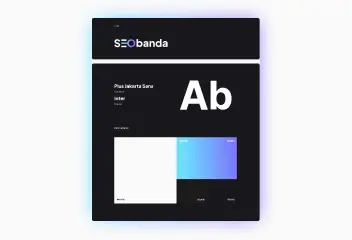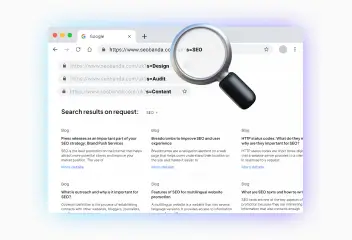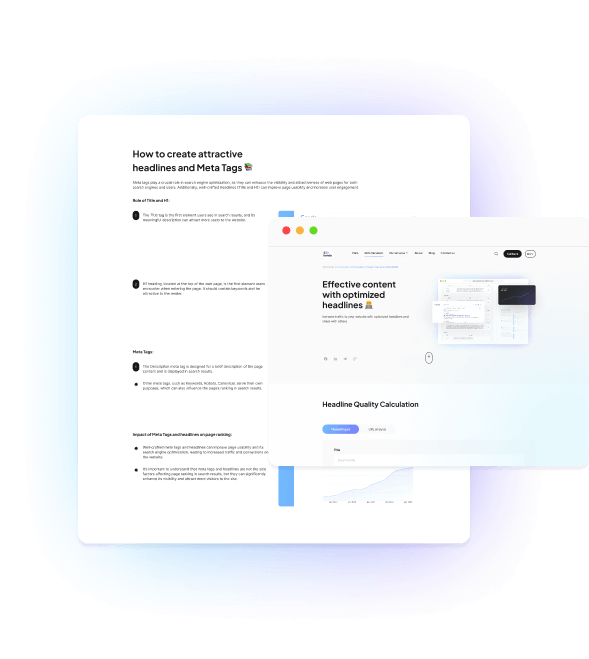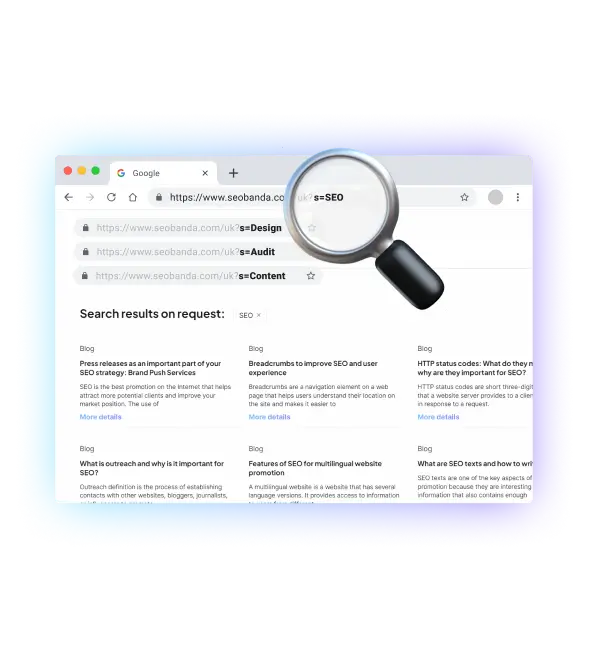

Meta tags
The purpose of tags are service words that contain important information about a web document for search engines. Such words include Title, Description, H1 tags. There are times when experts who are just starting to work in this field optimize all content within the HEAD tag with the META element. But you need to know which meta tags are important for SEO optimization .


How to write meta tags?
Due attention should be paid to:
- syntax – that is, how the meta tag should be written in the site’s HTML code
- requirements that search engines put forward for tags
- templates of correct and incorrect completion of tags.
Special characters, punctuation marks and stop elements (period, question marks and exclamation marks) should not be used, as these marks reduce the relevance of keywords. It is important to make the title attractive so that crawlers issue the most relevant queries. As for the length of the Title, it should be about 65 characters. Since Google calculates length in pixels, 420 to 550 pixels is recommended. If the Title length exceeds the recommended length, an ellipsis appears in the Snippet, which takes up extra space in the title.


How to write a description?
The purpose of this tag is to make the snippet more attractive, increase the CTR and attract the visitor. Various symbols, arrows and phone numbers are added to it. SEO Description requirements should reveal the essence of the page, several suggestions can be included in it. It should also be different on all pages of the resource and be repeated on other sites. This tag should not be the same as Title.
Its length should not be less than 140 and more than 162 characters, if we talk about pixels, it is recommended from 1100 to 1250 pixels. The description should include a description of the main advantages of the company, product or service.


H1 meta tag
It should indicate the most popular query that drives the page. H1 should only have 1-3 words. The exception is the pages of projects, products or articles. We are talking about those pages that are promoted in response to requests on the topic and are not used so often. This tag must be located inside the container anywhere. SEO requirements The tag can be entered only once per page, and if it is not there at all, it will be considered an error. The title should include the main keyword on the page, but it should be readable. In length, this tag should be no more than 70 characters and be unique, not similar to pages on other sites.
If we are talking about goods, it is advisable to enter the main parameters of the product in the thesis, i.e. color, length, model and width.


H2-H6 tags that benefit SEO
They are not meta tags, but visible to users and included in the content. H2-H6 are the tags of the logical structure of the document. Each page should contain one heading, which is contained in the H1 tag. As for subheadings, they all consist of H2-H6 tags. The content structure on the page should look like this:
- First level header.
- Second level header.
- Third level header.
When the user places the tags from H1 to H6, he must consider the sequence. Example: H1 is followed by H2 only, and H2 is followed by H3.


Checking meta tags on the site
In order to carry out the correct technical optimization of the resource, it is enough to understand the basic meta-tags for SEO. In order to be sure that the meta-data is entered correctly, it is worth conducting an SEO audit of the site. In addition to checking the filling in of tags for correctness, the expert must perform an analysis:
- resource semantics;
- internal and external influencing factors;
- user actions, etc.
As a result, you can get an extended report, which will include recommendations for the correct optimization of the site.


How to make meta tags correctly?
Title and Description meta tags are quite important components of internal optimization. Therefore, in order to write the title and description correctly, it is important to follow the rules. First you need to choose the key phrases that you need to make these tags. It is necessary to compile a semantic core using services specially designed for this purpose, for example, Google Adwords
As an example, you can take high-frequency search requests regarding the repair of apartments in the Kyiv region. They can be as follows:
- repair of apartments;
- repair of apartments in Kyiv;
- apartment repair price;
- turnkey repair of apartments, etc.
In the meta tags for the resource, it is necessary to indicate one keyword that is most suitable for the section. Title can look like this: “Renovation of apartments: the price of turnkey renovation of apartments in Kyiv.” If a certain area is being promoted, it is worth making several sections. At the same time, in the heading for each district, write its name separately. In order to fill in the description, you can use requests of average frequency and those that did not fit into the Title line.
The article becomes more complete and accessible, you can enter prices and time of work. You can also specify various discounts and promotional offers, enter your phone number and address. It is not difficult to write meta tags correctly, it is enough to follow the basic requirements and rules and correctly compose the semantic core.
Conclusion
On-page optimization is work carried out with the aim of optimizing a certain page for search ranking factors. The main points for all sites are the Title and Description meta tags, as well as a human-readable URL for the page and media files. This includes H1-H6 headings, media content, alt and title attributes of media files, external and internal links. Also the internal and external links from the page, link anchors, text, download speed, contacts, reviews and prices. The list of highlights also includes social buttons and their activity, target action button, valid HTML code, micro markup and other similar services.
You may also like it

Brand identity: The key to brand recognition and SEO success
Every product has its own unique feature that sets it apart from other brands. It could be a special font, a unique mascot, or an interesting logo with the right...

What is a dynamic URL and its impact on SEO
A dynamic URL (Uniform Resource Locator) is a web address that changes depending on the user's request or specific parameters. It differs from a static














